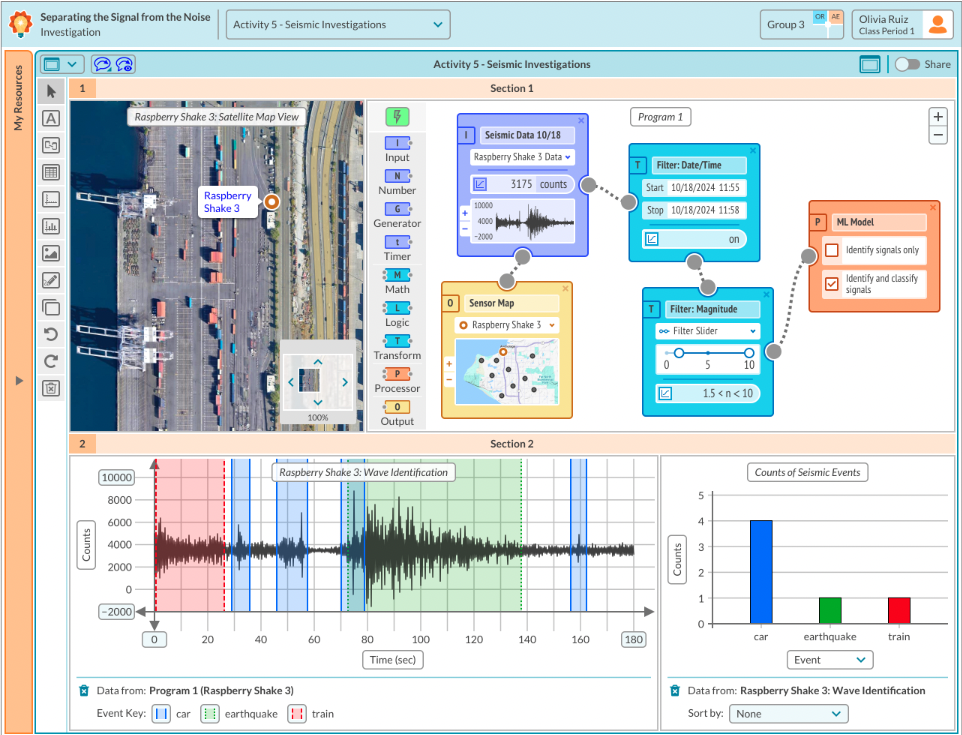The Concord Consortium is proud to announce a new grant from the National Science Foundation, titled Separating the Signal from the Noise (or SeismicML for short). This three-year project with Kent State University, the University of Washington, and the Anchorage School District will design, develop, and test computational tools that enable middle and high school students to investigate natural and human-caused seismic events with state-of-the-art machine learning algorithms.

Making sense of seismic activity
Anchorage is an ideal location for engaging students in an innovative exploration of seismic data. Situated close to the edge of the North American tectonic plate, Alaska experiences thousands of earthquakes annually. There are also frequent rock slides and avalanches that send tremors through the Earth’s crust. In addition, Anchorage’s location on the coast means there are also vibrations from the ebb and flow of tides and the crashing of waves against the land.
And added to all that natural seismic activity, human activity causes noticeable movement on Earth’s surface. From construction sites to concerts, roadway traffic, and sporting events, the Earth is constantly vibrating.
But with all the seismic activity out there, how can seismologists and students alike make sense of it? The answer lies in the power of machine learning.
All around the world, sensors and seismometers are constantly detecting seismic wave signals. In the past, scientists had to process that data manually, but with new machine learning (ML) techniques, they’re now able to automatically analyze the vast amounts of seismic data being collected every day. A type of artificial intelligence (AI) focused on pattern recognition, machine learning makes it possible to analyze massive datasets and to make data-driven discoveries. Thanks to AI, geoscientists can detect 10 or more times the number of quakes than were previously identified in an area.
Our SeismicML project will bring these authentic science practices to students.
Machine learning in science class
We are developing a one-week curriculum module that integrates computer science and machine learning practices with investigations central to the work of modern seismologists. Middle and high school students will explore natural and human-caused seismic events from data collected both in their schools and around Alaska. Students will build scientific and computational knowledge as they query and analyze real-world seismic data to answer their own questions.
Within the inquiry-based SeismicML module, students will:
- explore the occurrence of earthquakes in the community by installing scientific-grade seismometers in their school,
- use machine learning to identify and classify seismic events,
- create data visualizations of seismic events registered at their school, and
- construct programs that import real-time seismic data to find patterns in seismic events over different time periods and across different regions.
Modeling seismic data
SeismicML is building on our Dataflow platform, which is a visual model of the “flow” of data through a system. The Dataflow platform will import data from Raspberry Shake seismometers installed in participating Anchorage classrooms as well as thousands of other Raspberry Shake sensors throughout Alaska and around the world, and display it in real time. Students will use this seismic data to investigate seismicity in their local area.

The Dataflow programming interface (upper right) with a mock-up of the blocks students can connect to process incoming seismic wave data (bottom left). Students will be able to choose specific stations to import data from and view those stations on a map (upper left).
Dataflow programming, like other block-based programming, consists of connecting blocks just as one would connect Legos, for example. Students will connect specialized blocks and program them to take in seismic data, then process and output the data. They will also use blocks to filter and transform the data, run the data through an ML model trained to identify and classify seismic waveforms, and ultimately create multiple visual representations of the results. Because Dataflow is block-based, middle and high schoolers with little to no previous coding experience can focus on scientific inquiry and sensemaking without worrying about tedious code syntax.
We are working closely with three teacher partners in Anchorage who have prior experience with computer science teaching to develop and refine the SeismicML version of Dataflow and the curriculum module. We will then expand to additional teachers to explore how students translate their understanding of seismic waves into an algorithmic model as they investigate and classify the sources of seismic signals.
Research goals
The SeismicML project will investigate the benefits of integrating computational practices in science classrooms on students’ attitudes, perceived relevance of instruction, and content knowledge. We aim to generate important insights into the novel affordances of integrating geographically relevant data, geoscientific concepts, and authentic computer science and machine learning practices, as well as the scaffolds needed to support teachers to integrate this new approach.